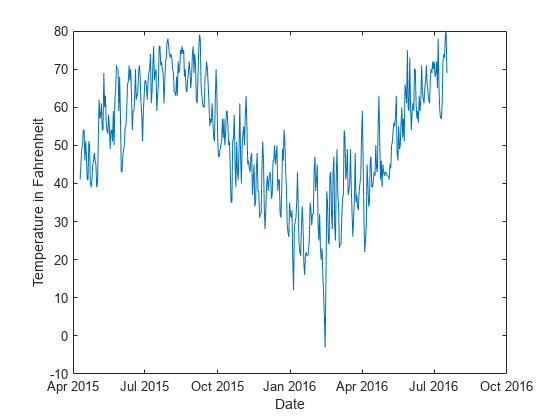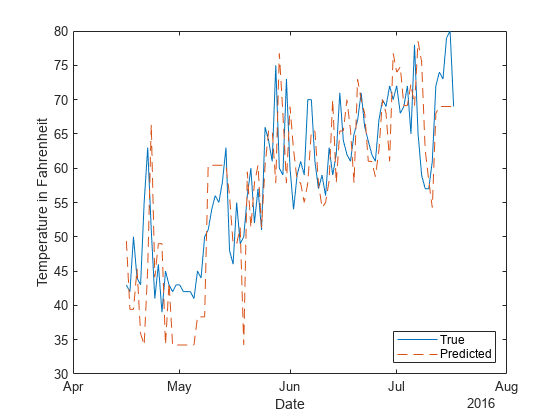After creating a DirectForecaster object, see how the model performs on observed test data by using the predict object function. Then use the model to forecast at time steps beyond the available data by using the forecast object function.
Load the sample file TemperatureData.csv, which contains average daily temperatures from January 2015 through July 2016. Read the file into a table. Observe the first eight observations in the table.
Year Month Day TemperatureF
____ ___________ ___ ____________
2015 {'January'} 1 23
2015 {'January'} 2 31
2015 {'January'} 3 25
2015 {'January'} 4 39
2015 {'January'} 5 29
2015 {'January'} 6 12
2015 {'January'} 7 10
2015 {'January'} 8 4
For this example, use a subset of the temperature data that omits the first 100 observations.
Create a datetime variable t that contains the year, month, and day information for each observation in Tbl. Then, use t to convert Tbl into a timetable.
Plot the temperature values in Tbl over time.
Partition the temperature data into training and test sets by using tspartition. Reserve 20% of the observations for testing.
Create a full direct forecasting model by using the data in trainingTbl. Train the model using a decision tree learner. All three of the predictors (Year, Month, and Day) are leading predictors because their future values are known. To create new predictors by shifting the leading predictor and response variables backward in time, specify the leading predictor lags and the response variable lags.
Mdl =
DirectForecaster
Horizon: 1
ResponseLags: [1 2 3 4 5 6 7]
LeadingPredictors: [1 2 3]
LeadingPredictorLags: {[0 1] [0 1] [0 1 2 3 4 5 6 7]}
ResponseName: 'TemperatureF'
PredictorNames: {'Year' 'Month' 'Day'}
CategoricalPredictors: 2
Learners: {[1×1 classreg.learning.regr.CompactRegressionTree]}
MaxLag: 7
NumObservations: 372
Properties, Methods
Mdl is a DirectForecaster model object. By default, the horizon is one step ahead. That is, Mdl predicts a value that is one step into the future.
For each test set observation, predict the temperature value using Mdl.
predictedY=93×1 timetable
Time TemperatureF_Step1
___________ __________________
16-Apr-2016 49.398
17-Apr-2016 39.419
18-Apr-2016 39.419
19-Apr-2016 45.333
20-Apr-2016 35.867
21-Apr-2016 34.222
22-Apr-2016 45.333
23-Apr-2016 66.392
24-Apr-2016 44.111
25-Apr-2016 49
26-Apr-2016 49
27-Apr-2016 34.222
28-Apr-2016 43.333
29-Apr-2016 34.222
30-Apr-2016 34.222
01-May-2016 34.222
⋮
Plot the true response values and the predicted response values for the test set observations.
Overall, the direct forecasting model is able to predict the trend in temperatures.
Retrain the direct forecasting model using the training and test data. To forecast temperatures one week beyond the available data, specify the horizon steps as one to seven steps ahead.
finalMdl =
DirectForecaster
Horizon: [1 2 3 4 5 6 7]
ResponseLags: [1 2 3 4 5 6 7]
LeadingPredictors: [1 2 3]
LeadingPredictorLags: {[0 1] [0 1] [0 1 2 3 4 5 6 7]}
ResponseName: 'TemperatureF'
PredictorNames: {'Year' 'Month' 'Day'}
CategoricalPredictors: 2
Learners: {7×1 cell}
MaxLag: 7
NumObservations: 465
Properties, Methods
finalMdl is a DirectForecaster model object that consists of seven regression models: finalMdl.Learners{1}, which predicts one step into the future; finalMdl.Learners{2}, which predicts two steps into the future; and so on.
Because finalMdl uses the unshifted values of the leading predictors Year, Month, and Day as predictor values, you must specify these values for the specified horizon steps in the call to forecast. For the week after the last available observation in Tbl, create a timetable forecastData with the year, month, and day values.
forecastData=7×3 timetable
Time Year Month Day
___________ ____ ________ ___
18-Jul-2016 2016 {'July'} 18
19-Jul-2016 2016 {'July'} 19
20-Jul-2016 2016 {'July'} 20
21-Jul-2016 2016 {'July'} 21
22-Jul-2016 2016 {'July'} 22
23-Jul-2016 2016 {'July'} 23
24-Jul-2016 2016 {'July'} 24
Forecast the temperature at each horizon step using finalMdl.
forecastY=7×1 timetable
Time TemperatureF
___________ ____________
18-Jul-2016 62.375
19-Jul-2016 64.5
20-Jul-2016 66.889
21-Jul-2016 66.889
22-Jul-2016 70.5
23-Jul-2016 74.25
24-Jul-2016 74.25
Plot the observed temperatures for the test set data and the forecast temperatures.


